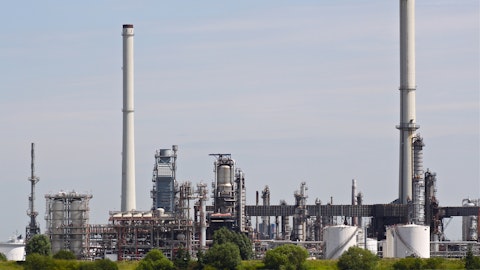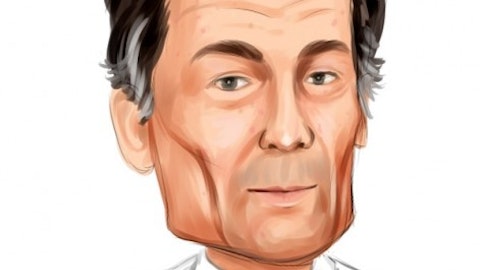Roger Kearns: Yes. Thanks. It’s Roger again. I think what we’ve seen on the export markets for both polyethylene and PVC is a bump up in pricing around the world. So, PVC is up by more than $0.10 a pound on the export side. And so that’s helping us. I would say we’re still, as Albert mentioned, little watch and see on China’s recovery. But India has come out quite strong and has really been, I would say, supporting a lot of the markets heading in that direction. So, we’re seeing improved pricing on exports. And at the same time, that helps a little bit on the — impacts a little bit the pressure or the pricing in the domestic market as well. But so, we’ll — as I mentioned earlier, our U.S. assets have a cost advantage on raw materials, and we plan to run them.
Angel Castillo: Helpful. And then you used to give a sensitivity to natural gas prices. Could you just remind us what I’ve got today, particularly given the volatility of our operating rates whether the lower cost kind of should flow through on a relatively immediate basis or if there’s a little bit of a lag, I don’t know, looking back to consider that.
Steven Bender: Yes. And so, we — the sensitivities that we provided are still appropriate here. When you think of natural gas in our markets, $1 in MMBTU is about $106 million of EBITDA impact. And certainly, when we think of — in our European business, a EUR 10 — 10,000 KWH is about EUR 10 million impact.
Angel Castillo: And that short number should flow quite quickly.
Steven Bender: Right.
Angel Castillo: Got it. Thank you.
Operator: And our next question comes from Eric Petrie from Citi. Your line is now open.
Eric Petrie: Good morning, everyone. Just going back to the exports. We saw a lot of competitive pressures from China exporting more caustic soda, more PVC. Think PVC prices in China right now are around $0.40 closer to $0.90 here in the U.S. domestic market. So, what are your expectations in 2023? And what have you seen year-to-date out of China?
Albert Chao: Yes. As China’s economy improves and China’s industry wouldn’t have to export low prices. And by the way, I think the PVC pricing quote in the U.S. is a list price, not the actual price. So certainly, U.S. can compete with any PVC producer around the world. And as Roger said that the industry, able to export. And we’re going forward still until the U.S. housing market returns, export will be a big part of the U.S. PVC producers. And China, they have a very high energy cost and even coal, some of the PVC are produced from coal-based technology. But the coal prices are also very high. So, I think China, they were exporting some quantities just to keep the plants running, but as total demand improves, be exporting less.
Eric Petrie: Thank you, Albert. And then maybe a question for Roger on your comment of the doubling of installations in China. What does that do to kind of supply-demand balances in the country? And then how much capacity is China adding this year and kind of what needs to be absorbed from last year?
Roger Kearns: Yes. So, I think wind in China is — China is a big driver of the wind market. And so, they’ve got RFQs out there, say, about double this year what they’ve done last year. That’s a good first step, I think, in really starting to absorb the extra capacity that’s come in as well as avoid the exports, right? So as Albert mentioned, with the China domestic market so slow, the China producers are exporting significant amounts. I think that will turn back inside and be used in China as opposed to hitting the export markets.
Eric Petrie: Thank you.
Operator: And our next question comes from Arun Viswanathan. Your line is now open.
Arun Viswanathan: Thanks for taking my question. Just curious, you made the comment about was well new construction does return. How much of your business really is tied to new construction now? I know within building products, you have some more exposure to repair and remodeling and — but it’s kind of muddy just because there is so many other overlapping factors. So how much of your business would you say is your sales or EBITDA is maybe tied to new construction? Thanks.
Albert Chao: Yes, Arun, our Building Materials business, about 50% is targeted to the new construction market and 50% to the repair and remodeling market. And as you heard earlier, Steve mentioned about the new home construction forecast to be going from 1.5 million units last year to about between 1.1 million, 1.3 million units this year and next year. That’s the forecast, and that’s about a 20% drop. And repair remodeling, as Steve also mentioned, index, they are looking at modest growth this year. So, if it’s 50-50 weighting then 20% drop in new construction, modest growth in repair, remodeling. We foresee potentially a 10% reduction in volume compared to last year. So that’s kind of order of magnitude estimate impact.
Arun Viswanathan: What about PEM? I mean, there is the PVC resin production, but that’s potentially offset by some of your infrastructure exposure there. How would you characterize the new construction exposure within PEM?





